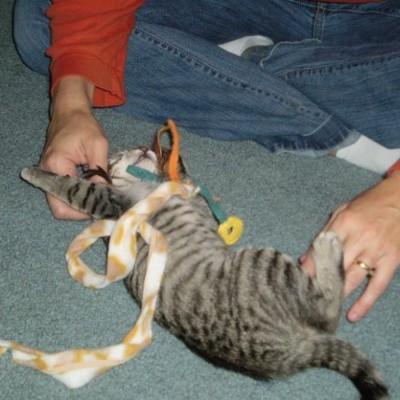
August 17, 2012
PetSafe® Expert
Roslyn McKenna
A Beginner’s Guide to Fostering Pets
By Roslyn Ayers, PetSafe Web Content Specialist
Fostering animals is many things to many people. You might have found a stray dog who needs to stay in your fenced-in backyard for a few days. Maybe your local shelter has asked you to keep a litter of kittens for a few weeks during kitten season until more space opens up. Or perhaps the shelter has had a very old cat for several years and you want to give him a good home for his remaining years.

You may have read my 8 reasons to foster. In this post, I’ll describe how you can foster animals and share some tips I’ve picked up over the years.

Tip #1: Bathrooms are ideal foster rooms for young puppies and kittens because accident cleanup is easier on tiled floors.
1) Know your physical limits.
There are 3 basic limits to fostering animals: space, time, and other responsibilities. You need to have a space for your fosters; a spare bedroom or screen porch is the perfect foster room. The size of the pet also affects how much space you’ll need; a bathroom would be too small for a large adult dog, but it would be perfect for a kitten or puppy.
Make sure you have enough time in your schedule to socialize and take care of a foster pet too. You may have other commitments, such as a job that takes you away from home for long periods. If you have other pets, make sure they will still get plenty of room in the house and playtime with you. Figure out your limits by asking yourself:
- What size pet can I handle?
- How do I feel about fostering on short notice?
- Do I prefer short-term or long-term?
- Does my landlord forbid certain breeds or set a maximum number of pets?
- How many animals should I foster at a time?
- Could I deal with an animal who might have medical or behavioral issues?

Tip #2: If you’ve got a separate room and don’t mind long-term fostering, consider fostering cats who test positive for Feline Leukemia. “Feleuks” live 2-5 years and are rarely adopted, so fostering gives them a few years in a great home.
2) Know your emotional limits.
Some people don’t foster cute kittens because they’ll be tempted to adopt them. Others choose not to foster injured, sick, or old animals because they would be too sad if the animals died. You know best what “gets to you” and what to stay away from, and you’ll get a better sense of this after your first few fosters. It’s also a good idea to take breaks between fosters so you don’t feel overwhelmed at the thought of always taking care of unwanted pets. You’ll also appreciate your own pets more.
3) Put your limits and expectations in writing.
Make sure you’re clear on how many animals you can take at a time and how long you can take them for. You don’t want to be stuck with an animal you don’t have time or room for. Most people foster through a shelter or rescue group, so make sure you pick one you trust. They will probably have you sign a fostering contract, and you should keep a copy of this too. They’ll tell you what you should expect and what they expect from you. Some questions to ask them include:

Tip #3: Put your personal rules for fostering in writing and get each family member to agree to them.
- How long will I keep each animal?
- Should the fosters be integrated into my household or kept separate?
- Who will pay for pet supplies such as food, cat litter, dishes, and leashes?
- Who will take the animal to the vet and pay for medical bills?
- What kind of training and behavior assessment will I need to do?
- Will I need to bring the animal to adoption events?
- Will potential adopters come to my home?
- What if I am unable to foster anymore?

Tip #4: Some people prefer to foster certain dog breeds, such as Yorkies or Westies, because they feel they know a lot about their foster’s personality already.
4) Start small.
I recommend fostering a healthy adult cat or dog for a few weeks first. The longer you keep the foster, the harder it can be to return them. You can increase the length of time per foster gradually, as you learn your limits.
Cats are probably the easiest pets to foster, since they require less space and no potty breaks. Then again, if you’ve already got a dog, adding another dog to your daily walks might not be so tough, provided they get along and both have good leash manners.
5) Think big.
Fostering is a great way to save many animals’ lives. Many people refer to themselves as “failed fosters” because they adopted their fosters instead of giving them back. Don’t be tempted to adopt a foster unless there’s a very good reason to. If you're worried about their potential adopter, the shelter or group you work with can tell you about their adoption standards so you’ll know what kind of forever family your foster pet will go to.

Tip #5: Have a foster you want to adopt? Ask your friends and family if need a new pet. If they decide to adopt, you can still visit your favorite foster. Don't pressure them into a decision though.
It happens to everyone; you foster a great pet and decide you can’t bear to give them back. That’s fine if your pet has just passed away and you're replacing a “spot” in your furry family, or if you have plenty of room for an addition.
The problem is when adopting a foster means you don’t have the room or time to foster anymore. Think about it this way: in the 10-20 year lifespan of the pet you could adopt, how many fosters could you keep in that time if you didn’t adopt? How many lives could you save just by giving a few pets a little extra time? If you foster one cat a year, that could be as many as 20 cats saved by fostering instead of the 1 cat saved by adopting. If you foster four dogs a year, that’s 60 dogs saved. Compare those numbers before you consider adopting a foster.
Do you foster animals? Post any other tips for first-time foster families in the comments!
Get Email Updates
Subscribe to the latest news, promotions, & more from PetSafe® brand.
Sign up today for the latest news, promotions, and more from PetSafe® brand.



